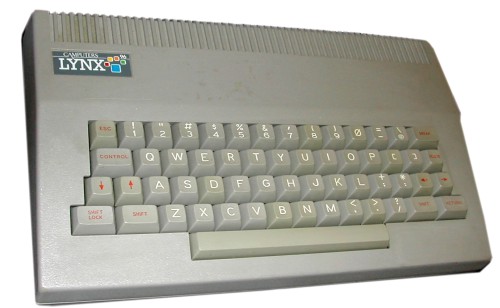Computer facts
| Company | Camputers |
|---|---|
| Type | home |
| Year | 1982 |
| End year | 1984 |
| Language | Lynx Basic, machine code monitor |
| CPU | Zilog Z80A |
| Speed | 4 MHz |
| RAM | 48 KB, 96 KB or 128 KB models available (max 192 KB) |
| ROM | 16 KB (48 KB version) and 24 KB (96 KB and 128 KB versions) |
| Text modes | 40 x 24 and 80 x 24 |
| Graphic modes | 256 x 248 and 512 x 480 |
| Colors | 8 |
| Sound | beeper |
| IO | TV RF, RGB, light pen, serial, cassette, interface extension port, power |
| OS | Optionally CP/M |

In my collection
Camputers LYNX
Currently unknown which version (memory model).Part of a bigger computer trade with Mikael Holm.
Trivia
The Lynx was an 8-bit British home computer that was first released in early 1983 as a 48 kB model. The designer of the Lynx was John Shireff and several models were available with 48 kB, 96 kB or 128 kB RAM. It was possible reach 192 kB with RAM expansions on-board.
The machine was based around a Z80A CPU clocked at 4 MHz, (6 MHz for the 128/192 kB models) and featured a Motorola 6845 as video controller. It was possible to run CP/M with the optional 5.25" floppy disk-drive on the 96 kB and 128 kB modells.
The machine was quite advanced for the time, but the high price (48 kB : £225, 96 kB : £299, 128k : £345) compared to its competitors, the Sinclair ZX Spectrum and the Oric 1, and lack of software was probably the reason for its short life. Approximately 30,000 Lynx units were sold worldwide.
Camputers ceased trading in June 1984. Anston Technology took over in November the same year and a re-launch was planned but never happened. In June 1986, Anston sold everything - hardware, design rights and thousands of cassettes - to the National Lynx User Group. The group planned to produce a Super-Lynx but was too busy supplying spares and technical information to owners of existing models, and the project never came into being.
Unique features of this computer (compared to other home computers at the time) includes: A quite large Basic, including graphics commands, in line CODE sentence for inclusion of machine code in hex. Unlike most other computers interpreting from text, the lines were precompiled and stored in reverse polish binary format. All numbers were floating point BCD numbers (even line numbers). A monitor program allowed hex dumps, copy, compare etc. The computer always ran in "high" resolution graphics mode (256x252 pixels in eight colours) using 6 times 10 pixels characters. Only a few bytes of graphic memory could be manipulated during the horisontal sync period, and thus graphics were extremely slow compared to most other computers; but better looking! Up to 192 kB of RAM and 20 kB of ROM (16 kB on the smallest model) on a 16 bit address bus was implemented using special hardware. As a consequence, certain RAM areas shadowed by ROM could only be used for data storage and the video memory had a green and alternative green bank that could be switched by a hardware register. For sound it had a simple (4 bit ?) DAC. A comparator was included to serve as an ADC (primarily used for reading from tape drives).
Compared to say the Commodore 64 the Basic was way more extensive and faster and resolution of graphics was better; but computer games on the other hand suffered from the special implementation and lack of hardware for sound and sprites. Thus, it was better for exploring programming or working with math.
